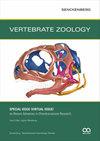Amphibian areas of endemism: A conservation priority in the threatened Mexican cloud forest
IF 2.3
2区 生物学
Q1 ZOOLOGY
引用次数: 2
Abstract
Amphibians of the Mexican Cloud Forest have a great diversity but are highly threatened. Forest endemisms are useful for recognizing biodiversity hotspots; furthermore, the interaction of historical and current events has generated areas of endemism that can be used for biological conservation in forest fragments; therefore, their identification is an essential part of the management and planning of biological conservation. Thus, our objective was to identify areas of endemism in the cloud forests of Mexico through the analysis of geographical distribution of 126 species of amphibians, as well as their conservation status to obtain information that supports the selection of priority areas for conservation. For this, the endemicity analysis method was used with three spatial scales, 1°×1°, 0.5°×0.5° and 0.25°×0.25° (lat/long), to achieve more complete results and avoid visual overrepresentation of areas of endemism. Seventeen consensus areas distributed in four of the five provinces of the Mexican Transition Zone were identified. The province of the Sierra Madre del Sur exhibited the highest amount of endemism areas, followed by the Sierra Madre Oriental, the East of the Trans-Mexican Volcanic Belt, and the Altos de Chiapas. Results indicate that the endemic areas of the Sierra Madre Oriental and Sierra Madre del Sur provinces are composed of amphibians included in the IUCN red list and the Official Mexican Standard NOM-059. Thus, the small areas of endemism in eastern and western Sierra Madre del Sur, nested within larger ones may be used to increase the protected areas of cloud forests in Mexico.地方性两栖动物区:受威胁的墨西哥云雾林的保护重点
墨西哥云雾森林的两栖动物种类繁多,但受到高度威胁。森林特有现象有助于识别生物多样性热点;此外,历史和当前事件的相互作用产生了可用于森林碎片生物保护的特有地区;因此,它们的识别是生物保护管理和规划的重要组成部分。因此,我们的目标是通过分析126种两栖动物的地理分布及其保护状况,确定墨西哥云雾森林的特有区域,以获得支持优先保护区域选择的信息。为此,采用1°×1°、0.5°×0.5°和0.25°×0.25°(纬度/长度)三个空间尺度的地方性分析方法,以获得更完整的结果,避免在视觉上对地方性区域的过度表征。确定了分布在墨西哥过渡区五个省中的四个省的十七个协商一致领域。南部马德雷山脉省显示出最多的地方性地区,其次是东部马德雷山脉,跨墨西哥火山带东部和阿尔托斯德恰帕斯。结果表明,东马德雷山脉省和南马德雷山脉省的流行区主要由列入IUCN红色名录和墨西哥官方标准NOM-059的两栖动物组成。因此,在东部和西部的马德雷山特有的小区域内,巢在较大的区域内,可以用来增加墨西哥云雾林的保护区。
本文章由计算机程序翻译,如有差异,请以英文原文为准。
求助全文
约1分钟内获得全文
求助全文
来源期刊

Vertebrate Zoology
ZOOLOGY-
CiteScore
4.00
自引率
19.00%
发文量
42
审稿时长
>12 weeks
期刊介绍:
Research fields covered by VERTEBRATE ZOOLOGY are taxonomy, morphology, anatomy, phylogeny (molecular and morphology-based), historical biogeography, and palaeontology of vertebrates.
 求助内容:
求助内容: 应助结果提醒方式:
应助结果提醒方式:


